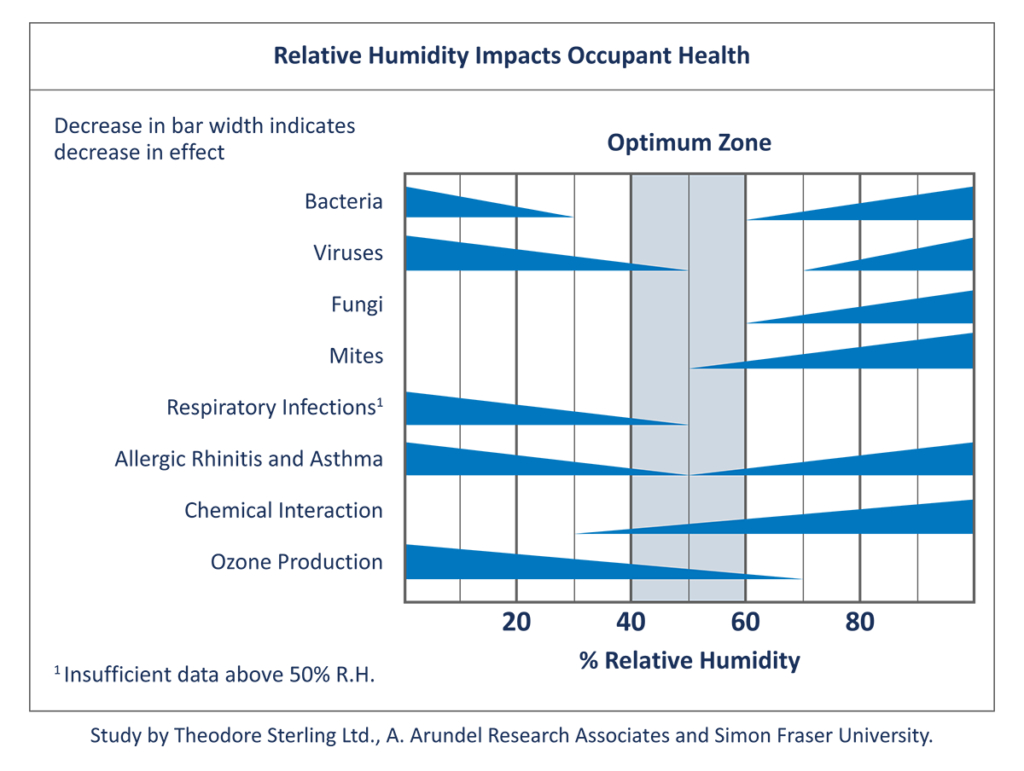CHAPTER TWO
Poor indoor air quality makes swimmers and lifeguards sick, plain and simple. Sadly, this is well documented and the bane of competitive swimming and the indoor pool industry in general. Temperature and relative humidity play a critical role in human comfort levels. It is essential that both are controlled and stable. While temperature control is generally well understood and mastered by designers, it is important to recognize the special temperature levels that natatorium patrons expect. The space temperatures in a natatorium are unique to each project and assumptions must never be made. Proper control of relative humidity levels is also a concern because of the direct effect on human comfort and health. Figure 1 demonstrates that relative humidity levels outside the optimum zone 40-60% range can result in human vulnerability to disease. These diseases include bacteria, viruses, fungi, mites, and other contaminants that lower air quality and will potentially lead to respiratory issues.
While 40% is certainly an acceptable indoor relative humidity level, most indoor pools do not operate at lower than 50% RH due to significantly increased operating costs.
- At lower RH levels, the pool evaporation rate increases dramatically. This increases both the dehumidification load and the pool water heating requirement.
- In cold climate applications, it is important to ensure no more outdoor air be introduced than what the codes require. More is not better in this case as it causes the RH levels to plummet to as low as 20%, dramatically increasing air and pool water heating costs.
- Swimmers leaving the water will also feel chilly at lower relative humidity levels due to evaporation off their bodies.
FIGURE 1: RELATIVE HUMIDITY IMPACTS OCCUPANT HEALTH
The type of facility being designed will typically dictate the space temperature. Table 1 helps target some typical conditions. It is critical to understand who will be using the facility in order to deliver the conditions most likely to satisfy them.
TABLE 1 – NATATORIUM DESIGN CONSIDERATIONS
| Pool Type | Air Temperature (°F) | Water Temperature (°F) |
|---|---|---|
| Competition | 75 to 85 | 76 to 82 |
| Diving | 80 to 85 | 84 to 88 |
| Elderly Swimmers | 84 to 85 | 85 to 90 |
| Hotel | 82 to 85 | 82 to 86 |
| Physical Therapy | 80 to 85 | 90 to 95 |
| Recreational | 82 to 85 | 80 to 84 |
| Whirlpool/Spa | 80 to 85 | 102 to 104 |
| Kids Swim Schools | 86 to 92 | 88 to 92 |
GENERAL NOTES
Discuss the planned operation of the facility with the operator to establish operating temperatures and general expectations.
- Facilities with warmer water temperatures tend to have warmer space temperatures. Warmer spaces have higher dew points and will have condensation issues unless the building is designed suitable for this application.
- Physical therapy facilities will often cater to the comfort of the therapist rather than the patient. The patient is generally not in the space for more than an hour, whereas the therapist is there all day. The designer should consult local codes. Some states require a full purge of the clinic room air with 100% outdoor air for every hour of occupancy.
- Elderly swimmers and kids swim schools tend to prefer much warmer air and water temperatures.
- Maintain relative humidity between 50% and 60% RH. Allowing the RH to go to 60% in summer will help reduce operating costs and equipment size while eliminating condensation concerns (condensation occurs only in cool/cold weather).
